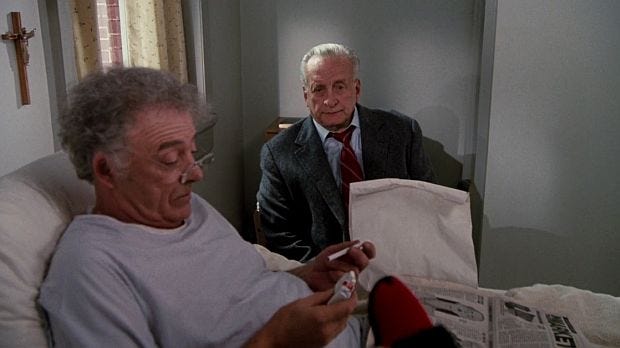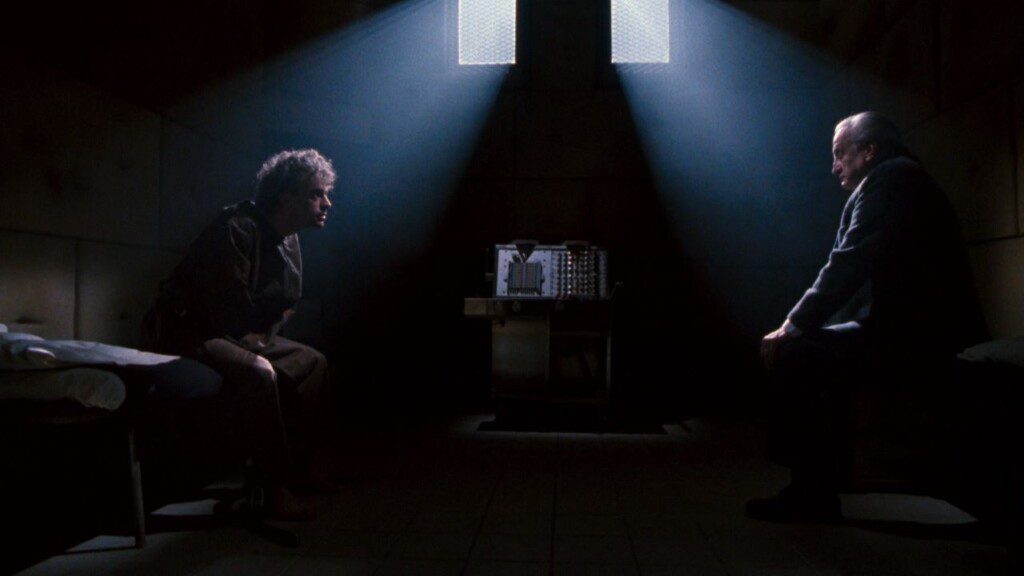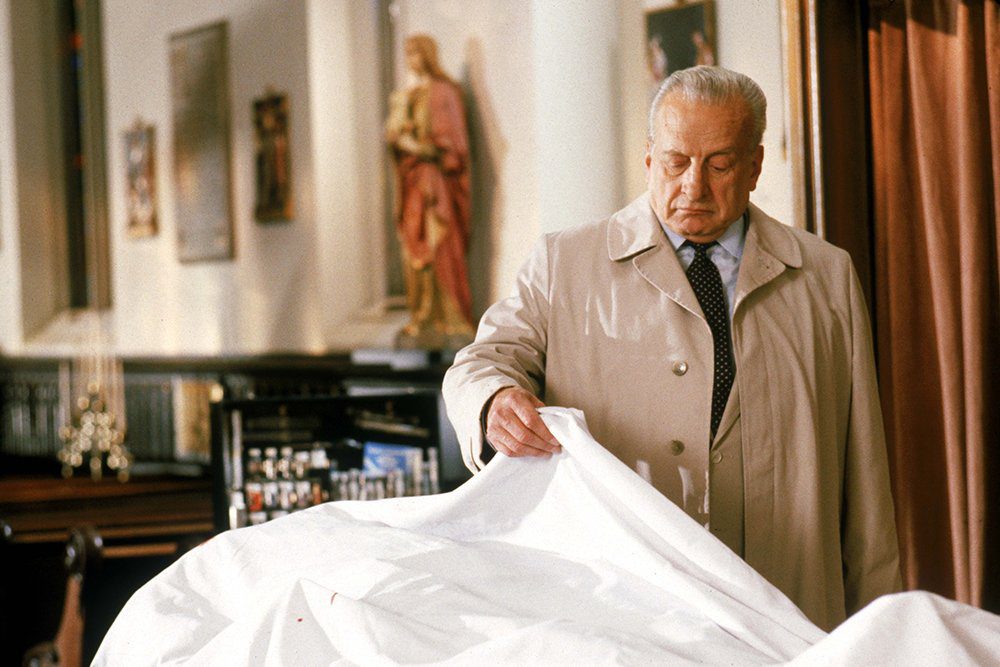“There I was, so awfully dead in that electric chair.”
Here’s how you make a sequel to The Exorcist. I knew going into this that The Exorcist III: Legion is better-regarded than the execrable Exorcist II, but even forearmed with that knowledge the jump in quality knocked me on my ass. Legion ignores everything about The Heretic, which could conceivably make its way on to any number of worst-ever lists (sequels, horror movies, sci-fi movies, movies in general), instead bringing back Exorcist author William Peter Blatty to write and direct. We even hear a snippet of Mike Oldfield’s “Tubular Bells,” which played so famously during Max von Sydow’s arrival to Regan’s exorcism. All Blatty had to do was make a film better than The Heretic, a bar so easy to clear that it’s downright laughable. Instead he made one of the best horror films of all time.
The real coup of Legion was the casting of George C. Scott in the role of Lt. Bill Kinderman (replacing the late Lee J. Cobb, who died before this began production). Scott had the uncanny ability to vacillate between rage, horror, and sorrow, and Legion calls for all three, while occasionally letting him be surprisingly funny, and even sweet. There’s positive masculinity on display here, as Kinderman goes to see It’s a Wonderful Life with Father Joseph Dyer (Ed Flanders, replacing William O’Malley). They were both great friends of the late Damien Karras, and know each other well enough to know that the other will be feeling low on the anniversary of Karras’s death. Their dialogue crackles like a Neil Simon play, and their chemistry is easy and believable. Scott gets an intense, hilarious monologue about a live fish in his bathtub, and as the camera closes in tight on the two men you can see Flanders stifling laughter. (It would be hard not to laugh at the absurdity of the intense Oscar winner in your face saying, “I can’t go home until the carp is asleep.”)

Make no mistake, though, Legion is grim. The plot kicks into motion when we see helicopters circling like buzzards around the docks. A Black boy has been discovered murdered in a spectacularly gruesome fashion: steel ingots driven into the eyes, decapitated, his head replaced with that of a Jesus statue, painted in blackface. Notably we don’t see this carnage; Scott’s crestfallen face does the heavy lifting for us, and does it well. Kinderman seems like he’s watching goodness itself being sapped from the world. The dead boy is horrific enough, but what’s worse for Kinderman is that the body bears the hallmarks of victims of the Gemini Killer. One problem: the Gemini has been dead for fifteen years.
Much of Legion takes place in a hospital, where Dyer finds himself after a health scare. Kinderman shows up, almost sheepishly, with a burger and a stuffed penguin. We get more of the film’s novelistic dialogue when Dyer asks “Can you pick me something up?” and Kinderman moans, “My god, the grammar.” Unfortunately, Dyer lives up to his name and is discovered completely exsanguinated. In a chilling image, neat vials of his blood are arrayed on his bedside table. Even more terrifying, some has been used to write on the wall: IT’S A WONDERFUL LIFE. In the course of Kinderman’s investigation he becomes aware of a mysterious patient – credited only as Patient X – whom he starts to believe is his friend Damien reincarnated. Or is it actually the Gemini?

Patient X is a bit of an ingenious approach to possession. He’s played by Jason Miller (who played Karras in The Exorcist) in terrific makeup, but when talking to Kinderman and gloating about his numerous kills as the Gemini, he’s played by national treasure Brad Dourif. This is not once confusing, and makes for some of Legion‘s scariest moments. The emotional centerpiece of the film comes in the form of a long conversation between Kinderman and the Gemini in which Kinderman is almost silent. He lets the Gemini talk as if he’s confessing, and the Gemini is happy to tell the story of how he possessed Karras’s body and is making him witness every act of brutality committed by his hands. In a lesser actor’s hands, the Gemini’s long exposition could come off as a hacky info dump, but Dourif is so terrifyingly compelling that you find yourself riveted instead of bored.
The great pleasure of Legion is just how confrontationally weird everything is. There’s a point to it, a reason, and we as viewers know we’re in capable hands with Blatty (this was his second and final fiml as a director, which is a shame). Take, for instance, the depiction of Heaven as a kind of ethereal train station, which would be crazy enough, but it also features Fabio as an angel and NBA great Patrick Ewing as the angel of death. There’s a kind of poesy and beauty to the scene that keeps it from being silly. Blatty’s terrific eye for staging extends to the film’s most famous sequence, a nearly-unbroken shot of a nurse doing her night rounds, which leads to one of the best jump scares in film history. And then there’s the climax – which Blatty initially fought against including; it’s absent in his director’s cut, one of the few of its ilk to be shorter than the theatrical version – which gives us some of Legion‘s most indelible imagery (a cell filled with snakes and flames) and the best of Scott’s performance.

I can’t really say enough good things about Legion. Apart from being one of the best films I’ve covered for this column, it’s one of the most unique and, frankly, unlikely. Any other attempt to sequelize The Exorcist has been a disaster (save for the sadly-departed TV show that ran for two seasons and is much better than you’d imagine). It’s almost not even fair to call this a sequel to The Exorcist. To me this is a Godfather/Godfather Part II situation: both masterpieces, and if you told me either one was your favorite I would agree with you.

